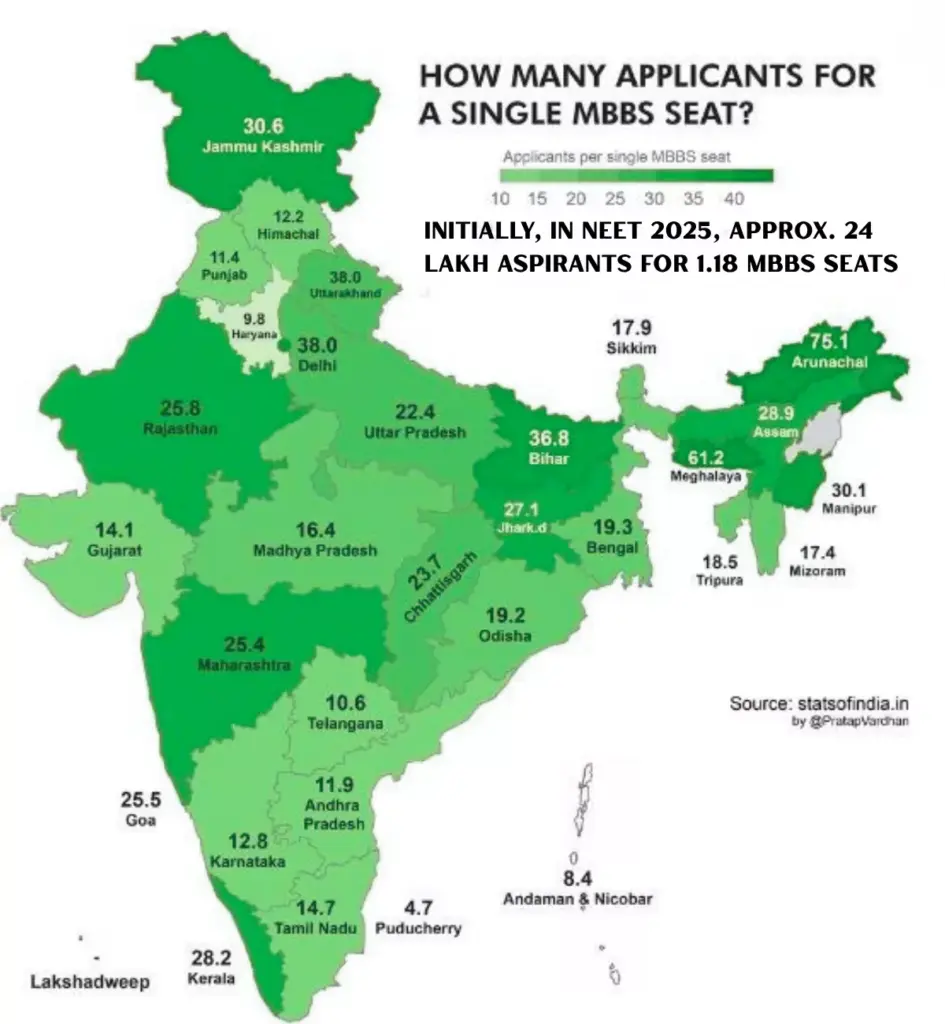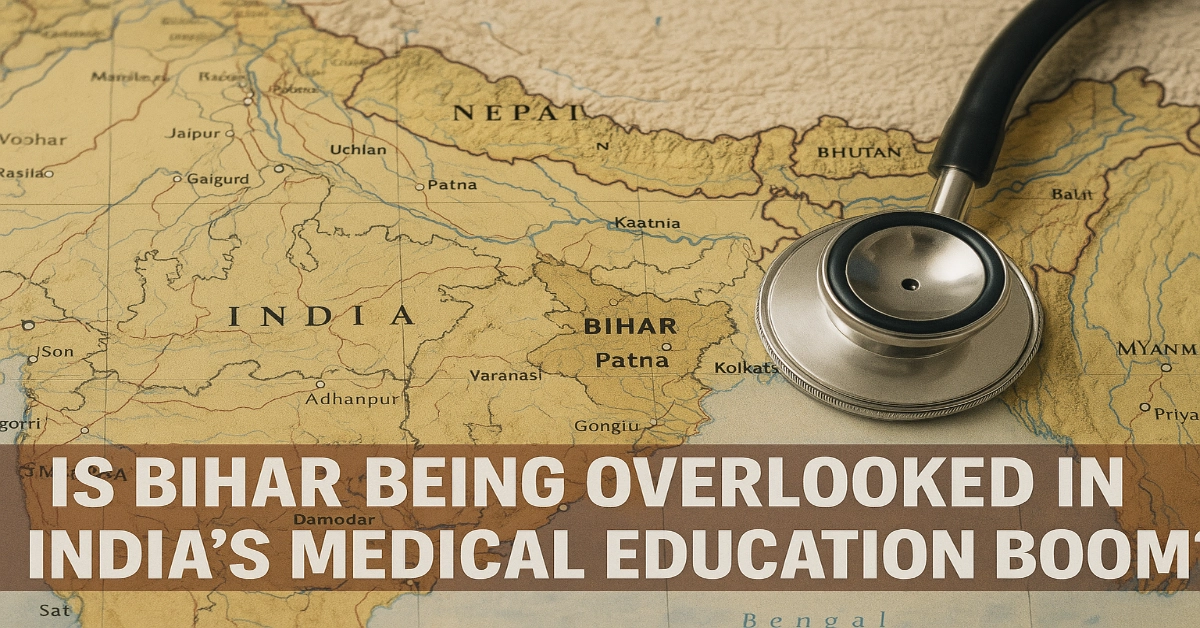Bihar 2025 Assembly Election: India’s medical education sector is expanding at an unprecedented pace. In 2025 alone, the National Medical Commission (NMC) approved over 9,000 new MBBS seats and 28 new medical colleges, signalling the Centre’s aggressive push toward self-sufficiency in healthcare manpower.
The Election Commission of India has declared the date for the Bihar 2025 Assembly Election, which will be held in two phases on 6 & 11 November.
But as Bihar gears up for its 2025 Assembly Elections, the conversation is shifting from national achievement to regional fairness.
Despite being one of India’s most populous states and one of its most underserved in terms of healthcare, Bihar continues to lag in MBBS seat allocation.
Will this expansion finally change Bihar’s medical education landscape, or will it remain another election-season talking point?

The Numbers Don’t Lie: Bihar’s MBBS Seat Deficit
Bihar has made some progress in the past decade, with new colleges opened in Gaya, Purnea, and Nalanda. But the data still tells a stark story.
| State | Population (Cr) | Total MBBS Seats (2025) | Seats per 1 Lakh Population |
|---|---|---|---|
| Tamil Nadu | 7.6 | 12,000+ | 15.2 |
| Karnataka | 7.5 | 12,000+ | 14.7 |
| Uttar Pradesh | 24 | 10,000+ | 4.4 |
| Bihar | 13.4 | ~2,540 | 1.9 |
Even after multiple rounds of expansion, Bihar’s MBBS seat-to-population ratio remains one of the lowest in India, less than one-fourth that of Tamil Nadu or Karnataka.
This imbalance is not just an academic issue; it has deep consequences for public healthcare delivery, youth employment, and regional development equity.
Read Also: NMC Updated Seat Matrix 2025: MBBS List Released
Bihar 2025 Assembly Election: Healthcare Expansion Meets Election Strategy
The JDU-BJP government in Bihar, in alliance with the Centre, is highlighting new medical projects as part of its 2025 campaign narrative. Announcements include proposals for colleges in Kishanganj, Katihar, Rohtas, Sheohar, Lakhisarai, Sheikhpura, Arwal, and upgrades to existing district hospitals to teaching status.
But the gap between proposals and operational colleges tells another story.
While 28 new colleges have been approved nationally, Bihar’s share remains limited to a handful of projects still awaiting final inspection or faculty recruitment.
This raises the question: “is Bihar truly a beneficiary of India’s medical education boom, or is it merely a political backdrop for national announcements?”
Read Also: NMC Diwali Bonanza: 812 Medical Colleges & 1,26,600 MBBS Seats for NEET Aspirants
Will Bihar Finally Get Its Fair Share?
Bihar’s claim for more MBBS seats rests on solid ground:
- It contributes 10% of India’s population but has less than 3% of its MBBS seats.
- Doctor-to-patient ratio in rural Bihar is among the worst in India, roughly 1 doctor for every 17,000 people (NITI Aayog, 2023).
- The health infrastructure index ranks Bihar near the bottom, even below smaller northeastern states.
Yet, while states like Karnataka and Tamil Nadu have seen rapid growth in new government and private colleges (thanks to central funding and PPP models), Bihar’s pace has been slower, bogged down by land approvals, faculty shortages, and bureaucratic delays.
Youth Aspirations and Public Sentiment
Every year, over 2 lakh students from Bihar appear for NEET-UG, but fewer than 3,000 MBBS seats are available within the state. This means that nearly 98% of aspirants are forced to compete for seats elsewhere, in southern states, or even abroad.
Among aspirants, the sentiment is clear: “We are not asking for charity. Bihar produces NEET toppers every year. We deserve medical colleges that match our talent.”
This rising frustration among middle-class families, especially in semi-urban districts, is turning medical education into a powerful electoral issue.
For the youth, MBBS seat expansion is not just about education; it’s about hope, opportunity, and belonging.
Read Also: MBBS in Bihar 2025-26: Admission Procedure, Eligibility, Colleges, Fees, Counselling Details etc.
What the Government Says
The BJP-JDU alliance claims it is committed to correcting the imbalance. Health department sources say at least six new government medical colleges are in advanced proposal stages, and two PPP-model projects are being evaluated under the Central Sector Scheme.
Union Health Ministry officials argue that Bihar’s seat expansion depends on meeting NMC’s faculty and infrastructure norms, not just political will.
However, the opposition RJD and Congress accuse the government of using the “medical education” narrative as election propaganda, pointing to delays in projects like Madhepura Medical College, which remains partially functional despite multiple inaugurations.
MBBS Expansion as Political Capital
From AIIMS-Patna’s success to new district colleges, medical infrastructure has become a symbol of development politics in Bihar.
In rural campaign trails, the ruling coalition is promoting the message that “A doctor in every village begins with a medical college in every district.”
But the difference between sanction and functionality remains the real test. A medical college on paper doesn’t treat patients or train doctors; it needs hospitals, faculty, and consistent funding.
In this sense, Bihar’s MBBS seat expansion could become a double-edged sword, a political talking point if delayed, or a transformative achievement if implemented effectively before the elections.
Read Also: List of Medical Colleges in Bihar 2025-26: MBBS, MD, MS, DNB, SS Seats etc.
Bihar’s Make-or-Break Moment
As the Bihar 2025 Assembly Election draws closer, MBBS seat allocation has emerged as more than just an education issue; it’s a litmus test for governance, equity, and federal fairness.
If the current government can deliver functional colleges, recruit qualified faculty, and bridge the seat deficit, it will not only win electoral goodwill but also reshape Bihar’s healthcare future.
But if promises remain on paper, Bihar’s youth will once again migrate, in search of the very opportunities that should have existed at home.

